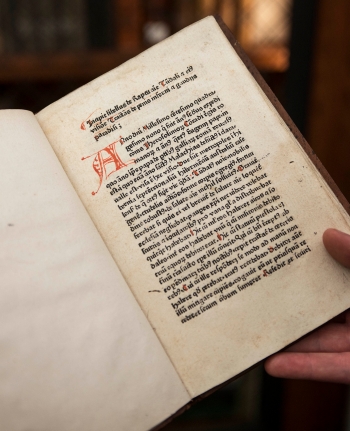
By
As visions of the after-life go, it’s pretty vivid stuff: souls melted and passed through sheets of iron again and again; thieves thrown against burning and freezing mountains; beasts torturing and mutilating those who led wasteful or avaricious lives.
Such was the vision of Tnugdalus, or Tundal, a wealthy, errant 12th-century Irish knight, as described in Vision of Tundal — believed to be the first printed book by an Irish author, a Benedictine monk named Marcus. Now, the first printed edition of the book, published in Cologne c.1472, resides in the John J. Burns Library, through an acquisition made possible by the Ladies Ancient Order of Hibernians — whose papers are archived at Burns — and former LAOH President Dorothy Weldon.
Tundal, notes Burns Librarian Robert O’Neill, was perhaps the most influential medieval visionary journey through Purgatory, Hell and Paradise before Dante wrote his Divine Comedy some 150 years later. Tundal was said to have experienced the vision in 1148, while he was unconscious over a period of three days.
In the vision, Tundal’s soul first travels through Hell, witnessing — and sometimes enduring — the torments of the damned. Later, he is transported to Paradise, seeing martyrs, saints, angels and the Holy Trinity, until he finally meets St. Patrick and four Irish bishops. The vision compels Tundal to repent and lead a pious life.
Brother Marcus, who claimed to have heard the story — which recalls a traditional Irish immrama, in which a hero visits the underworld — from Tundal himself, wrote his account in 1149. The Latin version of “Vision of Tundal” survived in more than 150 manuscripts, said O’Neill, and the text was translated into 15 vernacular languages. All printed versions are extremely rare, he notes: The first edition is represented in the US by only two other copies, archived at Yale and the J. Pierpont Morgan Library; only six copies of any other editions are in the US.
“As we’ve said before, Burns Library has the largest, most comprehensive collection of Irish research materials west of Dublin — and the addition of the Vision of Tundal greatly enhances that collection,” said O’Neill. “Apart from its historical significance to the religious-based literary tradition, the book — in its contents, form and origin — is a fascinating story in and of itself.”
The book was acquired from Paul Dowling of Liber Antiquus, who gave Burns Library first right of refusal, said O’Neill.



